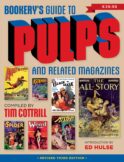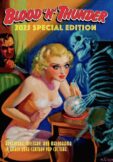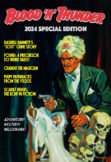EDitorial Comments
Birthday Boy: Johnston McCulley
Today we celebrate the birthday of Johnston McCulley, the creator of Zorro and one of the giants of pulp fiction. Born and raised in Illinois, he began his literary career as a crime reporter for The Police Gazette. McCulley turned to fiction writing in 1906 and made his pulp-magazine debut in the June issue of The Argosy. Over the next few years he cracked other Munsey pulps—The All-Story, Railroad Man’s Magazine—sold to Blue Book, and started writing for Street & Smith with yarns in Top-Notch.
In 1915, at the age of 32, he became one of the regular contributors to Street & Smith’s Detective Story Magazine, which evolved from the Nick Carter nickel weekly. The first of McCulley’s many series characters for that periodical was Black Star, a criminal mastermind who wore a cloak and a hood with a jet-black star on the forehead. These stories appeared under the pseudonym John Mack Stone, the first of many pen names McCulley used. (Others included Harrington Strong, Raley Brien, George Drayne, and Walter Pierson.) Although Black Star was a thoroughgoing villain, most of McCulley’s recurring characters in DSM were avenging angels or modern Robin Hoods—always working outside the law but committed to serving the interests of justice. Among them were The Thunderbolt, the Avenging Twins, the Man in Purple, and the unaccountably popular Crimson Clown. McCulley also score with Thubway Tham, a lisping pickpocket whose often-humorous exploits were chroncled first in DSM and later in Best Detective, a Street & Smith reprint title.
To the best of my knowledge, McCulley rarely if ever employed pseudonyms for his submissions to Argosy and All-Story Weekly. It was for the latter magazine that he created his most famous pulp hero, Senor Zorro, who first appeared in “The Curse of Capistrano,” a book-length novel serialized in five parts during the summer of 1919. The basic idea, involving a daring hero who poses as a foppish aristocrat, had already been used by Baroness Orczy in The Scarlet Pimpernel (1905), but where her story unfolded in Europe during the French Revolution McCulley set his in Old California during the late 18th century.
The initial Zorro adventure was clearly intended as a one-off, since at story’s end the character was unmasked and (presumably) headed for matrimony. But McCulley struck it rich when popular motion-picture actor Douglas Fairbanks licensed the novel for adaptation as his first self-produced, big-budget swashbuckler. The resulting film, The Mark of Zorro (1920), was an international sensation that boosted Fairbanks into stardom’s top rank. On the strength of its success McCulley quickly wrote and easily sold “The Further Adventures of Zorro” (1922), serialized in Argosy All-Story Weekly. “Curse of Capistrano” was published in hard covers by Grosset & Dunlap in 1924, retitled The Mark of Zorro to capitalize on the film. In 1925 Fairbanks produced and starred in a sequel, Don Q, Son of Zorro, which simply grafted McCulley’s character onto an adaptation of Hesketh and Kate Prichard’s “Don Q’s Love Story.”
McCulley wrote other high-adventure yarns with similar settings and Zorro simulacrums, but none seemed to have the same appeal. The original returned in a 1931 novel, Zorro Rides Again, also serialized in Argosy. Over the next few years he popped up in a handful of uncollected novelettes. The author had pretty good luck selling his other pulp stories to Hollywood, but he hit pay dirt again when Republic Pictures licensed the character for a 1936 feature film (The Bold Caballero) and a series of cliffhanger serials: Zorro Rides Again (1937), Zorro’s Fighting Legion (1939), Zorro’s Black Whip (1944), Son of Zorro (1947), and Ghost of Zorro (1949). Their mutually beneficial relationship was not affected by the 1940 release of a lavish 20th Century-Fox remake of The Mark of Zorro; Fox had purchased remake rights to the 1920 film from Fairbanks, but McCulley retained his hold on the character and gave Republic free rein to use Zorro in any way the studio deemed useful, as long as it didn’t attempt to adapt “Curse of Capistrano.”
The Fox film, which starred Tyrone Power, Linda Darnell and Basil Rathbone, made Johnston McCulley hot again and he was able to sell one last novel, “The Sign of Zorro,” to Argosy for serialization during 1941, as The Mark of Zorro was playing in the nation’s movie theaters. In 1944 he parlayed the character’s continuing popularity into a series of short stories for the Thrilling Group’s West, which had become a mundane pulp magazine. The Zorro series ran in West for seven years, and during that time McCulley revived his Detective Story Magazine characters Thubway Tham and The Crimson Clown for Thrilling’s detective pulps.
West lasted only a couple more years after dropping the Zorro series in 1951. Pulp magazines were dying, and after nearly a half-century of fictioneering Johnston McCulley was pretty well written out. He made sporadic short-story sales over the next few years but might easily have been forgotten but for Walt Disney’s 1957 licensing of Zorro for a TV series broadcast over the ABC network. Zorro was a huge hit that lasted for three seasons and continued to earn good ratings for years afterward in syndication.
McCulley died in 1958, having lived long enough to see his most famous creation revived for a new generation. I suspect he’d be amazed to learn that, another 50 or so years later, Zorro is still going strong in movies and on television.
On the basis of volume alone Johnston McCulley could be considered a hack. A fair percentage of his output was bland, trite, and/or repetitive. His various Detective Story series abound with familiar situations and character types, and like most high-volume producers who were active for a prolonged period, his later yarns cannibalized earlier ones. But like other pulp writers who enjoyed comparable longevity, McCulley was a natural storyteller whose stories, whatever their flaws, were never unreadable. He never lost sight of the quality that endeared him to editors: his ability to provide the masses with escapist entertainment. Altus Press and Wildside Press, to name just two specialty publishing houses, have reprinted some of his works. I recommend giving them a try.
2 thoughts on “Birthday Boy: Johnston McCulley”
Leave a Reply
Recent Posts
- Windy City Film Program: Day Two
- Windy City Pulp Show: Film Program
- Now Available: When Dracula Met Frankenstein
- Collectibles Section Update
- Mark Halegua (1953-2020), R.I.P.
Archives
- March 2023
- July 2021
- May 2021
- March 2020
- February 2020
- December 2019
- November 2019
- October 2019
- September 2019
- August 2019
- May 2019
- April 2019
- March 2019
- February 2019
- December 2018
- November 2018
- October 2018
- August 2018
- June 2018
- February 2018
- December 2017
- October 2017
- September 2017
- August 2017
- May 2017
- April 2017
- February 2017
- September 2016
- August 2016
- July 2016
- June 2016
- November 2015
- October 2015
- September 2015
- August 2015
- July 2015
- June 2015
- May 2015
- April 2015
- March 2015
- February 2015
- January 2015
- August 2014
- July 2014
- June 2014
- May 2014
- April 2014
- January 2014
- December 2013
- September 2013
- August 2013
- July 2013
- June 2013
- May 2013
- April 2013
- March 2013
- February 2013
- January 2013
- December 2012
- October 2012
- September 2012
- August 2012
- July 2012
- June 2012
- May 2012
Categories
- Birthday
- Blood 'n' Thunder
- Blood 'n' Thunder Presents
- Classic Pulp Reprints
- Collectibles For Sale
- Conventions
- Dime Novels
- Film Program
- Forgotten Classics of Pulp Fiction
- Movies
- Murania Press
- Pulp People
- PulpFest
- Pulps
- Reading Room
- Recently Read
- Serials
- Special Events
- Special Sale
- The Johnston McCulley Collection
- Uncategorized
- Upcoming Books
- Western Movies
- Windy City pulp convention
Dealers
Events
Publishers
Resources
- Coming Attractions
- Field Guide to Wild American Pulp Artists
- MagazineArt.Org
- Mystery*File
- ThePulp.Net








Nice writeup ED. He’s always been a favorite of mine.
Great article. I’ve always been a huge Zorro fan. And have my copy of Mark of Zorro on my keeper shelf.